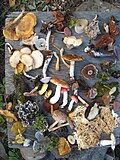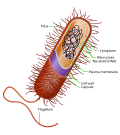 | An extremophile (from Latin extremus 'extreme', and Ancient Greek φιλία (philía) 'love') is an organism that is able to live (or in some cases thrive)... 62 KB (6,576 words) - 18:08, 12 May 2024 |
 | Microorganism (section Extremophiles) environments and sustained colonies; these organisms are known as extremophiles. Extremophiles have been isolated from rocks as much as 7 kilometres below the... 73 KB (7,724 words) - 19:08, 9 May 2024 |
A halophile (from the Greek word for 'salt-loving') is an extremophile that thrives in high salt concentrations. In chemical terms, halophile refers to... 22 KB (2,705 words) - 10:21, 13 March 2024 |
 | PMID 20086136. Brooks, Christopher (March 26, 2013). "The life of extremophiles: Surviving in hostile habitats". BBC Nature. Retrieved March 16, 2017... 155 KB (16,863 words) - 15:49, 28 April 2024 |
 | from cyanobacteria. Bacteria can be beneficial. This Pompeii worm, an extremophile found only at hydrothermal vents, has a protective cover of bacteria... 304 KB (29,026 words) - 22:50, 26 April 2024 |
 | Archaea (category Extremophiles) production and sewage treatment, and biotechnology exploits enzymes from extremophile archaea that can endure high temperatures and organic solvents. For much... 155 KB (16,478 words) - 16:15, 12 May 2024 |
 | and environmentally more diverse than multicellular life (see e.g., extremophile). "On the tree of life, based on analyses of small-subunit ribosomal... 181 KB (19,625 words) - 12:01, 6 May 2024 |
Lecturer in Victorian Literature at the University of Kent 25 June 2015 Extremophiles Monica Grady, Professor of Planetary and Space Sciences at the Open... 438 KB (278 words) - 00:07, 8 May 2024 |
 | Life (section Extremophiles) the biosphere. Some of these are harsh environments occupied only by extremophiles. Life has been studied since ancient times, with theories such as Empedocles's... 109 KB (10,600 words) - 15:52, 14 May 2024 |
 | Nematode (category Extremophiles) The nematodes (/ˈnɛmətoʊdz/ NEM-ə-tohdz or NEEM-; Greek: Νηματώδη; Latin: Nematoda), roundworms or eelworms constitute the phylum Nematoda. They are a... 70 KB (7,446 words) - 14:57, 14 May 2024 |
 | of Uzon Caldera. The Uzon Caldera is a location of the occurrence of extremophile micro-organisms due to its high localized temperatures.(C.Michael Hogan... 2 KB (133 words) - 02:40, 1 September 2023 |
David Kendrick (section The Extremophiles) the Extremophiles Is Now Available" (PDF). InverseSquareFilms.com. December 21, 2003. Retrieved February 24, 2021. "David Kendrick". The Extremophiles web... 23 KB (2,259 words) - 21:41, 7 April 2024 |
 | species of Archaea form endospores. The first observed archaea were extremophiles, living in extreme environments, such as hot springs and salt lakes... 132 KB (13,788 words) - 09:25, 9 May 2024 |
Biosignature Brookings Report Exotheology Extraterrestrials in fiction Extremophile Hemolithin History of the extraterrestrial life debate MERMOZ Nexus for... 13 KB (1,358 words) - 12:52, 13 May 2024 |
Mesophile (section Mesophiles vs. extremophiles) comprising the human microbiome. Mesophiles are the opposite of extremophiles. Extremophiles that prefer cold environments are termed psychrophilic, those... 12 KB (1,442 words) - 22:05, 11 May 2024 |
 | known, unlikely. Some scientists have speculated that thermoacidophilic extremophile microorganisms might exist in the cooler, acidic upper layers of the... 214 KB (19,463 words) - 14:16, 8 May 2024 |













